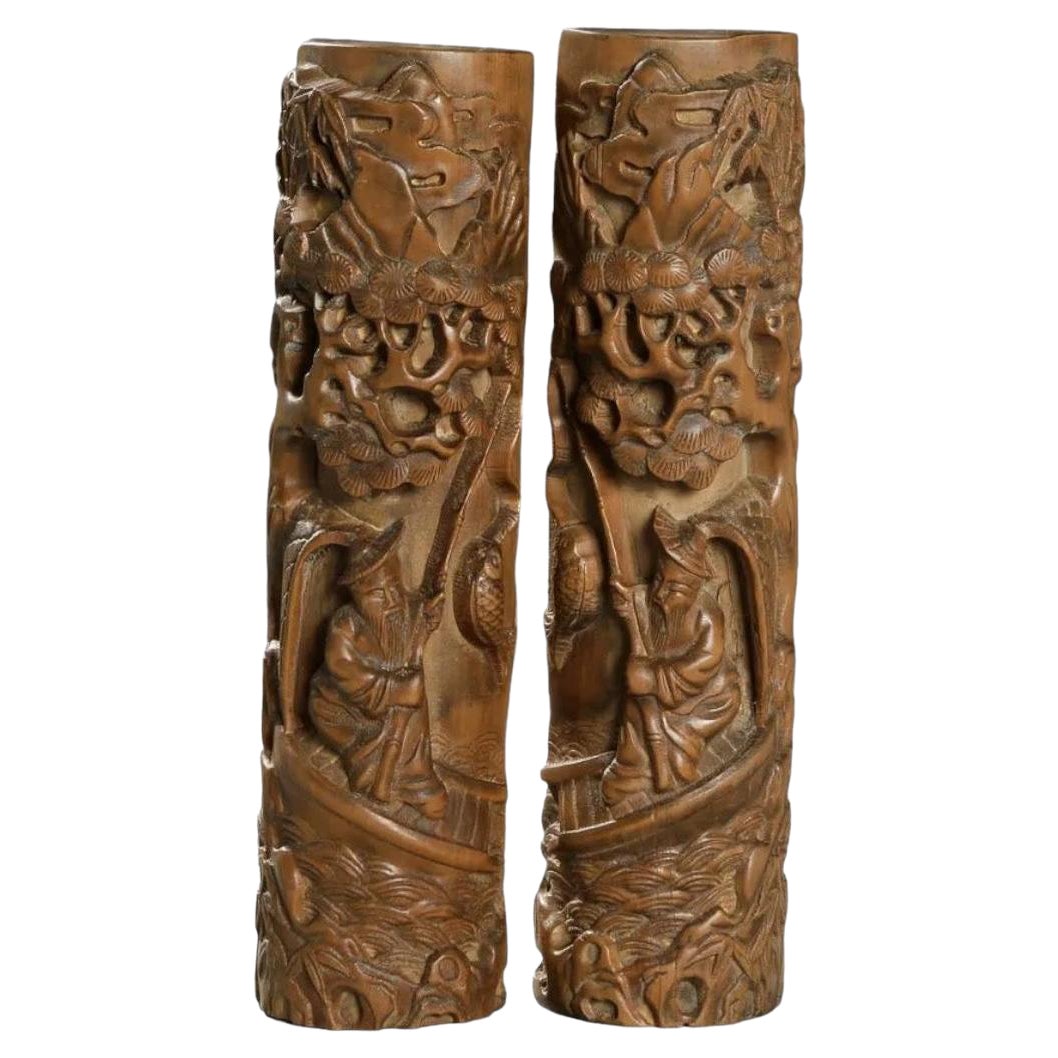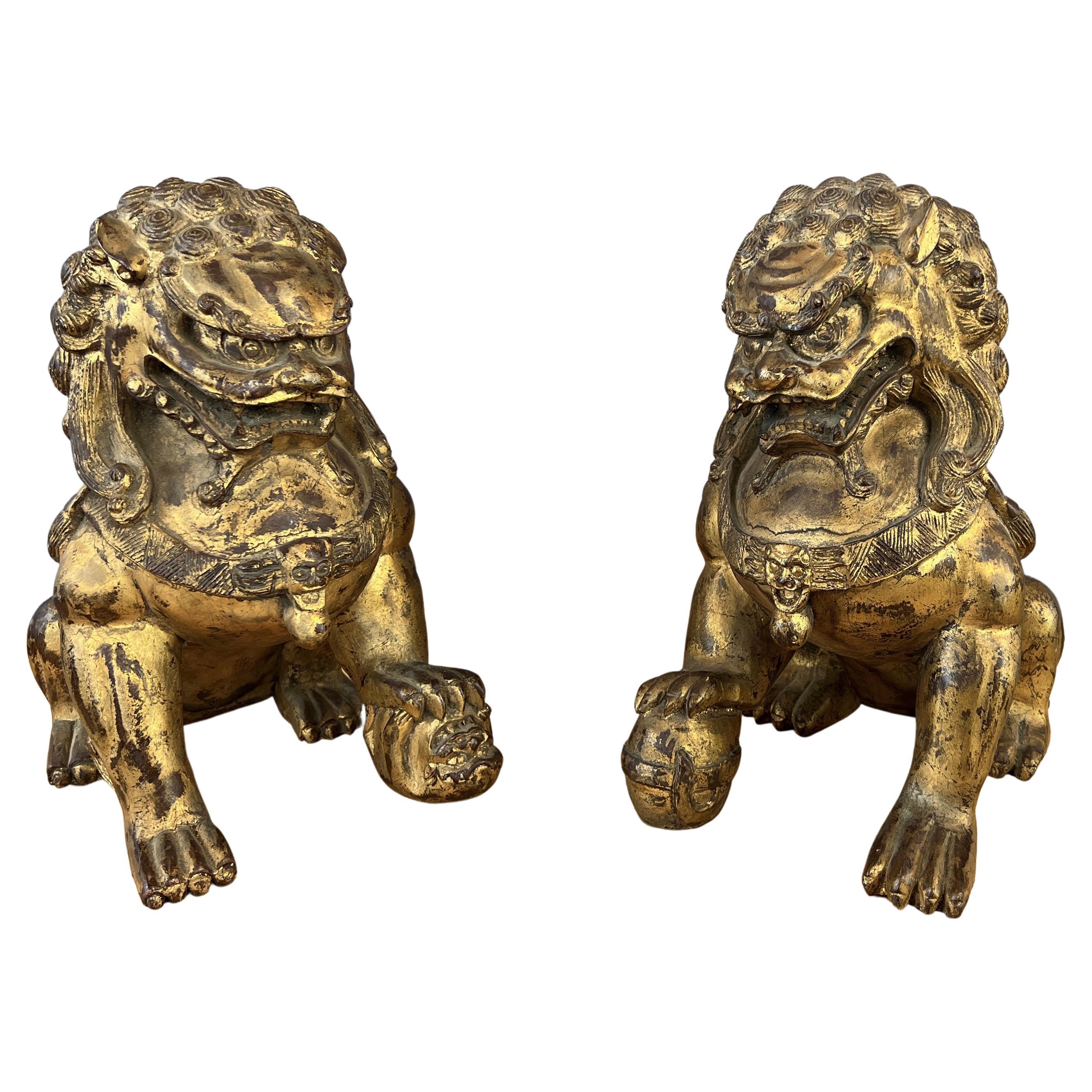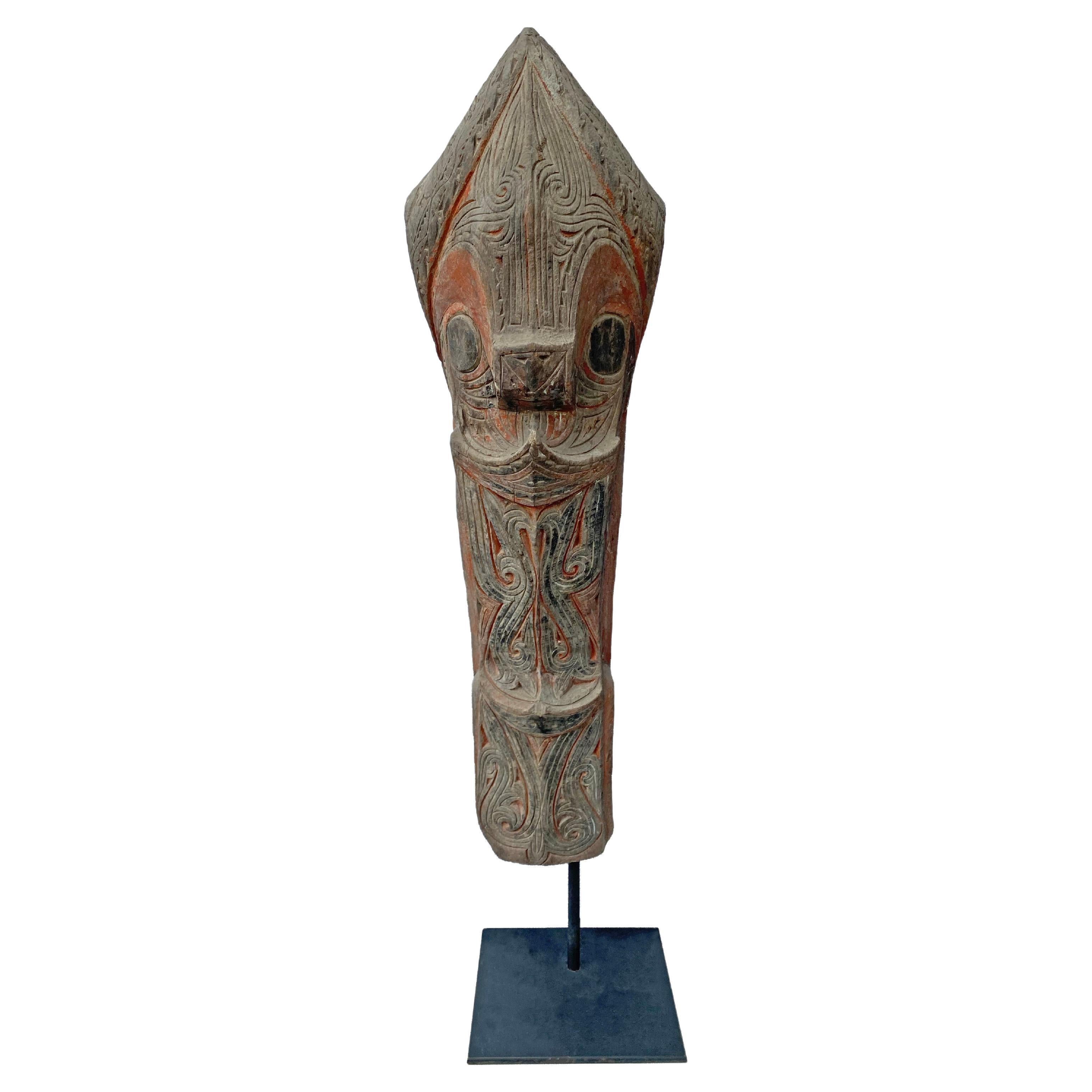Items Similar to Pair of Japanese Gilt Wood Komainu, Guardian Lions, Early 20th Century, Japan
Want more images or videos?
Request additional images or videos from the seller
1 of 20
Pair of Japanese Gilt Wood Komainu, Guardian Lions, Early 20th Century, Japan
About the Item
A charming and mischievous pair of Japanese carved, gilt and painted komainu, often mistaken for foo dogs or foo lions, Showa Period, 1920's, Japan.
The two komainu, or guardian lions, are portrayed seated upon their haunches, heads slightly turned. The two beasts are well carved, with wonderful musculature, flowing manes, and bushy tails. Their faces a mix of ferocious and comical. The eyes of reverse painted glass with gilt highlights.
One is a true komainu, (lion-dog), with a horn on its head, and its mouth closed. The other is a shishi, (lion), with its mouth open, and no horn. The komainu sports a mane and tail pigmented blue with gilt highlights. The shishi sports a mane and tail pigmented green with gilt highlights. Both figures richly gilt in gold lacquer.
Komainu are protective beings, similar to foo lions or foo dogs, but specific to Shinto shrines. They are always depicted in pairs - one with its mouth open, the other with its mouth closed. The guardian with its mouth closed also sports a horn to its head is referred to as the komainu (lion-dog), while its partner is usually referred to as a shishi (lion). When paired together, the pair are collectively referred to as komainu.
The komainu presented on custom wooden bases.
Measurements of lions only: approximately 17.5" H x 16" W x 10" D each.
- Dimensions:Height: 22.5 in (57.15 cm)Width: 21.5 in (54.61 cm)Depth: 14.5 in (36.83 cm)
- Style:Showa (Of the Period)
- Materials and Techniques:
- Place of Origin:
- Period:
- Date of Manufacture:circa 1920
- Condition:Additions or alterations made to the original: Set on later custom wooden bases. Wear consistent with age and use. Minor losses. Minor structural damages. Minor fading. The gilding worn in some areas, revealing the black lacquer or wood beneath. Both lions with loss of pigments to the manes and tails, some revealing the wood underneath. The open mouth lion with a cracked eye.
- Seller Location:Austin, TX
- Reference Number:1stDibs: LU894723050102
About the Seller
5.0
Platinum Seller
These expertly vetted sellers are 1stDibs' most experienced sellers and are rated highest by our customers.
Established in 2001
1stDibs seller since 2010
305 sales on 1stDibs
Typical response time: 1 hour
- ShippingRetrieving quote...Ships From: Austin, TX
- Return PolicyA return for this item may be initiated within 7 days of delivery.
More From This SellerView All
- Pair of Japanese Gilt Bronze Komainu by Ishikawa Komei, Meiji PeriodLocated in Austin, TXA striking pair of Japanese gilt bronze komainu by the renowned Japanese sculptor, Ishikawa Komei (1852-1913), Meiji period, Japan. The pair well cast, and robustly modeled. They ar...Category
Antique Late 19th Century Japanese Meiji Sculptures and Carvings
MaterialsBronze
- Japanese Bronze Okimono of a Carp, Taisho Period, Early 20th Century, JapanLocated in Austin, TXAn elegant Japanese cast bronze okimono of a swimming carp, Taisho Period (1912 - 1926), early 20th century, Japan. The graceful fish portrayed realistically in motion, as if swimmi...Category
Vintage 1920s Japanese Taisho Sculptures and Carvings
MaterialsBronze
- Nepalese Gilt Bronze Buddhist Figure of Manjushri, Early to Mid-20th CenturyLocated in Austin, TXA lovely Nepalese gilt bronze figure of Manjushri, the Bodhisattva of Wisdom, early to mid 20th century. The Bodhisattva of Transcendent Wisdom ...Category
Mid-20th Century Nepalese Tibetan Sculptures and Carvings
MaterialsLapis Lazuli, Bronze
- Nepalese Gilt Bronze Bodhisattva 'Amoghapasha?', Early to Mid-20th CenturyLocated in Austin, TXA beautiful and unusual gilt bronze figure of a Bodhisattva, possibly Amoghapasha, Nepal, early to mid-20th century, circa 1930s or 1940s. The regal figure possibly depicting the bodhisattva Amoghapasha, the Unfailing Lasso. The enlightened being is portrayed seated upon a high double lotus pedestal. He is dressed as an Indian prince, wearing a luxurious foliate patterned dhoti around his waist and a billowing scarf around his shoulders. . His torso bare save for the jeweled necklaces and the sacred thread. A five pointed crown with an image of Amitabha Buddha in the central point graces his head. His princely face cold painted with beautiful detail, his hair colored blue with crushed lapis lazuli, indicating his peaceful nature. Amoghapasha holds a lasso in one hand, an axe in the other. He is considered an emanation of Avalokiteshvara. A bodhisattva of compassion, Amoghapasha is so named because of the lasso he holds in his hand. The lasso represents his vast compassion which is thought to extend to encompass all beings, bringing them into a state of perfection and enlightenment. The copper base plate, seemingly a later replacement, has been inscribed with a visvajra (double vajra...Category
Mid-20th Century Nepalese Tibetan Sculptures and Carvings
MaterialsLapis Lazuli, Bronze
- Large Carved Gilt Teak Standing Buddha, Northern Thailand, Early 20th CenturyLocated in Austin, TXA large, tall Thai standing carved teak wood Buddha, lacquered and gilt, with hand raised in abhaya mudra, far Northern Thailand or possibly Laos, early 20th century. Near life-siz...Category
Early 20th Century Thai Sculptures and Carvings
MaterialsTeak
- Japanese Gilt Wood Fukukenjaku Kannon, Meiji Period or Earlier, JapanLocated in Austin, TXAn attractive and esoteric Japanese carved and gilt wood figure of Fukukenjaku Kannon, Amoghapasa, Meiji period or earlier, Japan. Fukukenjaku Kannon is portrayed in an usual six...Category
Antique Early 1900s Japanese Meiji Sculptures and Carvings
MaterialsCypress
You May Also Like
- Early 20th Century Pair of Chinese Wood Carving SculpturesLocated in North Miami, FLPresenting an exquisite pair of early 20th-century Chinese wood carvings that exude artistry and cultural richness. These masterfully crafted piece...Category
Early 20th Century Chinese Sculptures and Carvings
MaterialsWood
- Vintage Pair Chinese Gilt Carved Wood Foo Dog / Guardian Lions FigurinesLocated in San Francisco, CAOffered here are a pair vintage Chinese gilt and carved wood Foo Dog/Guardian Lions figurines Wonderful craftsmanship with the hand carving that has gone...Category
Vintage 1940s Chinese Chinese Export Sculptures and Carvings
MaterialsGiltwood
- Singa Guardian Sculpture from the Batak Tribe of Sumatra, Early 20th CenturyLocated in Jimbaran, BaliA Batak Tribe “Singa” from the Indonesian island of Sumatra. This mythical lion figure was used as a protective architectural element on the corner of a traditional Batak house. It f...Category
Early 20th Century Indonesian Other Sculptures and Carvings
MaterialsWood
- Singa Guardian Sculpture from the Batak Tribe of Sumatra, Early 20th CenturyLocated in Jimbaran, BaliA Batak Tribe “Singa” from the Indonesian island of Sumatra. This mythical lion figure was used as a protective architectural element on the corner of a traditional Batak house. It f...Category
Early 20th Century Indonesian Other Sculptures and Carvings
MaterialsWood
- Singa Guardian Sculpture from the Batak Tribe of Sumatra, Early 20th CenturyLocated in Jimbaran, BaliA Batak Tribe “Singa” from the Indonesian island of Sumatra. This mythical lion figure was used as a protective architectural element on the corner of a traditional Batak house. It f...Category
Early 20th Century Indonesian Other Sculptures and Carvings
MaterialsWood
- Pair Of Chinese Hardstone Guardian LionsLocated in Norwood, NJPair of hand carved Chinese Jade hardstone Foo Lions or Fu Dogs. This pair of Chinese spinach jade appears to be a nephrite, covered vases having a figural foo lion design with raise...Category
Antique Late 19th Century Chinese Chinese Export Sculptures and Carvings
MaterialsJade





